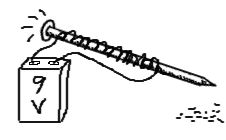
Purpose
To find out how electromagnetism works by constructing an electromagnet and be able to answer the question “How does electromagnetism work?”
Additional information
Do you ever wonder how the telephone, electric bell, and electric motors that run most of our appliances at home work? Electricity can be transformed into energy of motion or mechanical energy and it is all because of the discovery made by Professor Hans Christian Oersted in 1820. Professor Oersted is a physics professor who discovered that a wire carrying electric current generated a magnetic field. He referred to this phenomenon as electromagnetism. An electromagnet operates only when there is a flow of electricity in the coil of the wire. Its magnetism can be turned on and off at will. It is made up of an iron core, wire, and source of electrical energy.
Sponsored Links
Required materials
- half meter copper wire
- one dry cell
- 1iron nail about four centimeters in length
- electrical tape
- iron filings
Estimated Experiment Time
About fifteen minutes
Step-By-Step Procedure
- 1. Get a half meter long copper wire and remove the insulation at both ends.
- 2. Wound the wire around the nail.
- 3. Attach the ends of the poles to the dry cell.
- 4. Trace the path of electricity in this device.
- 5. Bring the nail near some iron filings.
- 6. Observe how the iron filings behave.
- 7. Predict what would happen if the wire was detached from the dry cell.
- 8. Detach one wire from one terminal of the dry cell.
- 9. Observe what happens.
Note
Be careful in removing the insulation of the copper wire to make sure you don’t damage it. Nails and ion filings are sharp so do not play with them. Wound the wire tightly and securely around the nail for positive results.
Observation
When you attached the ends of the wires to the poles of the dry cell, was the circuit close or open? What happened when you brought the nail near some iron filings? What happened to the iron filings when you detached one wire from one terminal of the dry cell? What property is exhibited by the nail when electricity flows along its wire?
Result
The circuit was closed when you attached the ends of the wires to the poles of the dry cell. When you brought the nail near the iron filings, they reacted to the nail as shown by their movements. After detaching one of the wires from the dry cell, the iron filings no longer showed any reaction to the nail. The nail in this experiment acted like a magnet. Electricity flowing in a conductor like the nail produces a magnetic field which results to magnetism. The nail attracts magnetic objects like the iron filings. The strength of an electromagnet is influenced by the number of turns it has on its coil, the material used and the amount of electricity in the wire. Electromagnets are found inside the telephone, washing machine, and many others.
Sponsored Links
Take a moment to visit our table of Periodic Elements page where you can get an in-depth view of all the elements,
complete with the industry first side-by-side element comparisons!